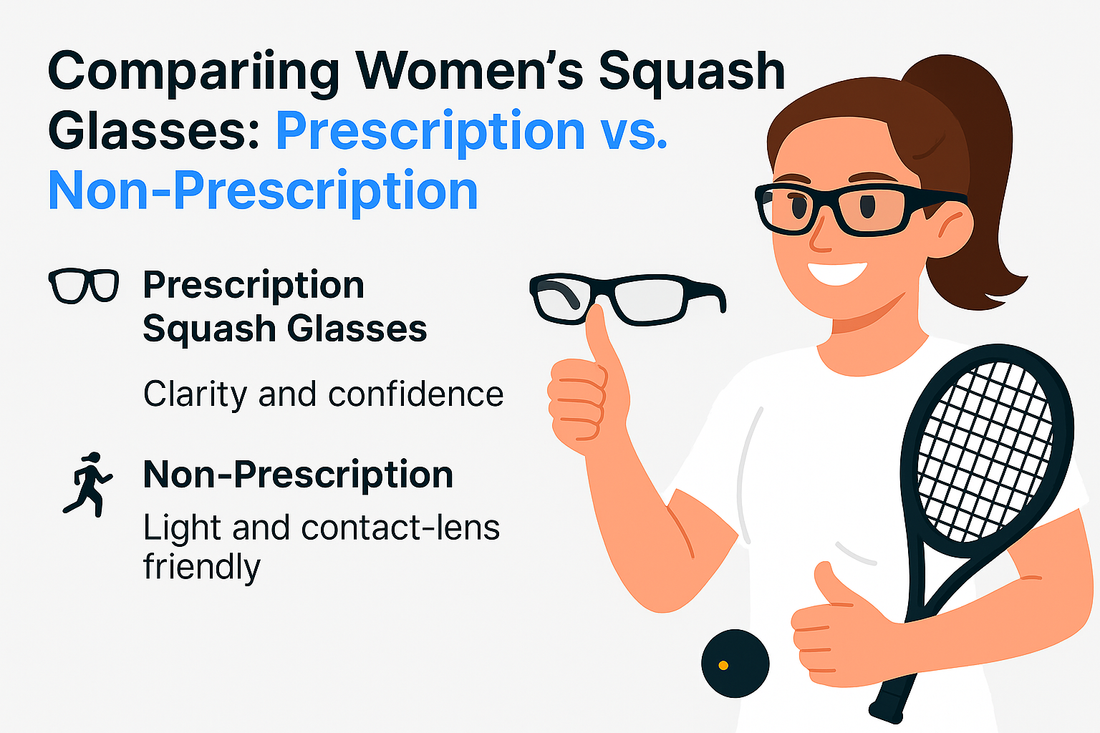
Comparing Women’s Squash Glasses: Prescription vs. Non-Prescription
Fast rallies and tight walls make squash one of the most eye-demanding sports. Clear vision and impact protection are non-negotiable, especially for women who need a dialed-in fit that stays put through quick cuts and pivots. If you are deciding between prescription and non-prescription squash glasses, here is a straightforward comparison to help you play sharper and safer. 👓
Prescription Squash Glasses: Clarity and Confidence
Prescription-ready glasses bring your full correction onto the court, eliminating the compromise of wearing regular frames or squinting through blur. You can choose from two main RX formats:
- Direct RX lenses - The lenses are made to your prescription and mounted into the sport frame. This offers excellent optics and a clean feel with fewer parts.
- RX inserts - A small prescription carrier sits behind an outer impact-resistant shield. Inserts are easy to update if your prescription changes and keep replacement costs down.
Benefits include reliable clarity, depth perception for wall shots, and fewer distractions. Consider single-vision for crisp distance or progressives if you need close-up clarity to check your smartwatch between games. Expect a slightly higher weight and price compared with non-prescription, plus production time for custom lenses.
Non-Prescription: Light, Quick, and Contact-Lens Friendly
Non-prescription squash glasses are ideal if you wear contacts or have no correction. They are ready to play right out of the box, tend to be lighter, and are often the most budget-friendly choice. Look for wraparound coverage, a secure strap, and venting to reduce fog. If you occasionally switch out of contacts, consider a model compatible with an RX insert later. 🏃♀️
Lens Materials and Coatings That Matter
For squash, choose impact-resistant lenses, most commonly polycarbonate. They are light, tough, and inherently UV-blocking. Some frames use nylon or TR-90 for flexibility and durability without pressure points.
- Anti-fog: Essential for warm courts. Hydrophilic or double-sided coatings help prevent steam-ups during long rallies.
- Scratch resistance: Hard coatings extend lens life. Use a case and microfiber cloth to protect the surface.
- Tints: Clear works in most indoor courts. Amber or light rose can add contrast under dim lighting, but avoid dark tints that reduce depth perception.
- Blue-light filters: Optional for off-court screens. Not required for indoor play but fine if you prefer them in an everyday RX.
Fit for Women: Comfort, Stability, and Style
A women-specific fit balances protection and comfort. Seek frames with a smaller lens-to-cheek distance, a narrow nose bridge option, and adjustable or interchangeable nose pads to prevent slippage. A low-profile strap that clears a ponytail keeps the frame stable without tugging. Wraparound temples and soft rubber grip points prevent bounce when you lunge or split-step. A secure, close fit also reduces fog by guiding warm air out through vents. ✅
Cost, Turnaround, and Durability
Non-prescription models cost less and are available immediately. Prescription options cost more due to custom lenses, especially for high prescriptions or progressive designs, and often require several business days to complete. In terms of longevity, sturdy frames with replaceable straps and lens options provide the best value. RX inserts help manage costs over time because you can replace the insert while keeping the outer shield.
Which Should You Choose?
- Choose prescription if you do not wear contacts, want maximum clarity and depth perception, or need progressives.
- Choose non-prescription if you wear contacts, want the lightest setup, or need a quick, affordable solution.
- Consider RX inserts if your prescription changes frequently or you want easy lens updates.
- Prioritize anti-fog and ventilation if your glasses fog during high-intensity rallies.
Care Tips to Extend Performance
- Rinse lenses with lukewarm water before wiping to avoid micro-scratches.
- Use a microfiber cloth and a sport-safe cleaner, not household sprays.
- Air-dry frames after sweaty matches and store in a hard case.
- Check straps, nose pads, and inserts regularly and replace worn parts. 🎯
FAQs
How do I decide between prescription and non-prescription squash glasses?
Choose prescription if you need vision correction and do not wear contacts. Non-prescription is best for contact lens wearers or players with no RX.
What lens material is best for women’s squash eyewear?
Polycarbonate is the go-to for impact resistance, light weight, and UV protection. Pair it with anti-fog and a hard coat for durability.
Can I wear contacts under non-prescription squash goggles?
Yes. Many players prefer contacts with non-prescription glasses for a light, simple setup. Make sure ventilation and anti-fog are included.
Do tinted lenses help on indoor courts?
Clear lenses work for most indoor courts. Light amber or rose can boost contrast in dim venues, but avoid dark tints that reduce visibility.
Why do my squash glasses fog up and how can I prevent it?
Heat and sweat create condensation. Choose frames with vents, apply anti-fog treatments, and maintain a snug yet breathable fit.



